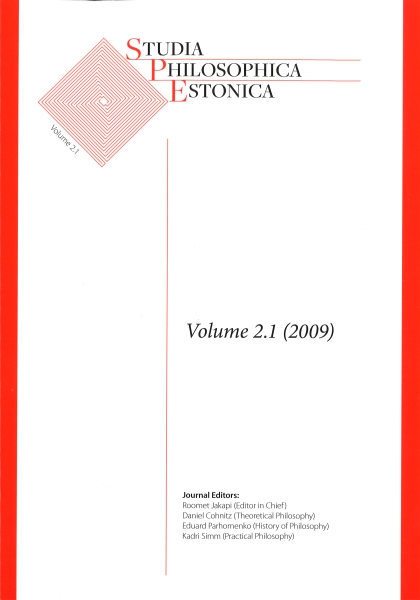The Realistic Fallacy, or: The Conception of Literary Narrative Fiction in Analytic Aesthetics
DOI:
https://doi.org/10.12697/spe.2009.2.1.01Keywords:
analytic aesthetics, fictionAbstract
In this paper, my aim is to show that in Anglo-American analytic aesthetics, the conception of narrative fiction is in general realistic and that it derives from philosophical theories of fiction-making, the act of producing works of literary narrative fiction. I shall firstly broadly show the origins of the problem and illustrate how the so-called realistic fallacy – the view which maintains that fictions consist of propositions which represent the fictional world “as it is” – is committed through the history of philosophical approaches to literature in the analytic tradition. Secondly, I shall show how the fallacy that derives from the 20th Century philosophy of language manifests itself in contemporary analytic aesthetics, using Peter Lamarque and Stein Haugom Olsen’s influential and well-known Gricean make-believe theory of fiction as an example. Finally, I shall sketch how the prevailing Gricean make-believe theories should be modified in order to reach the literary-fictive use of language and to cover fictions broader than Doyle’s stories and works alike.
Downloads
References
Austin,J. (1975). How to Do Things with Words, 2nd edn, Harvard University Press, Cambridge.
Ayer, A. (1936). Language, Truth and Logic, Gollancz, London.
Beardsley, M. (1981). Aesthetics: Problems in the Philosophy of Criticism, 2nd edn, Hackett Publishing, Indianapolis.
Beckett, S. (1953). L’innomable, Minuit, Paris.
Castañeda, H.-N. (1979). Fiction and reality: Their fundamental connections, Poetics 8: 1- 31-62.
Currie, G. (1988). Fictional names, Australasian Journal of Philosophy 66: 471-488.
Currie, G. (1990). The Nature of Fiction, Cambridge University Press, Cambridge.
Currie, G. (2004). Arts and Minds, Clarendon Press, Oxford, chapter Interpreting the Unreliable, pp. 134-152.
Davidson, D. (2005a). James Joyce and Humpty Dumpty, Truth, Language, and History, Clarendon Press.
Davidson,D. (2005b). Locating literary language, Truth, Language, and History, Clarendon Press, pp. 167-181.
Davidson, D. (2005c). A nice derangement of epitaphs, Truth, Language, and History, Clarendon Press, pp. 89-107.
Davies, D. (2007). Aesthetics and Literature, Continuum, London and New York.
Eldridge, R. (2006). Literature as material figuration: Benjamin, Sebald, and human life in time, in F. Ruokonen and L. Werner (eds), Visions of Value and Truth. Understanding Philosophy and Literature, Societas Philosophical Fennica, Helsinki, pp. 13-29.
Falck, C. (1988). Fiction and reality, Philosophy 63: 363-371.
Frege, G. (1948). On sense and reference, The Philosophical Review 57: 209-230. Translated by Max Black and Peter Geach.
Frege, G. (1956). The thought: A logical inquiry, Mind 65: 289-311. Translated by A.M. and Marcelle Quinton.
Gibson, J. (2007). Fiction and the Weave of Life, Oxford University Press, Oxford.
Goodman, N. (1984). Of Mindand Other Matters, Harvard University Press, Cambridge, chapter Fiction for Five Fingers, pp. 123-126.
Graff, G. (1979). Literature against Itself. Literary Ideas in Modern Society, The University of Chicago Press, Chicago.
Hart, H. (1951). A logician’s fairytale, The Philosophical Review 60: 198-212.
Hume, D. (2000). A Treatise of Human Nature, Oxford University Press, Oxford.
Inwagen, P. (1977). Creatures of fiction, American Journal of Philosophy 14: 299-308.
Irvin, S. (2006). Authors, intentions, and literary meaning, Philosophy Compass 1: 114-128.
Joyce, J. (1975). Finnegans Wake, Faber and Faber, London.
Knight, D. (2002). Intersections: Philosophy and literature, or why ethical criticism prefers realism, in J. Gracia, C. Korsmeyer and R. Gasché (eds), Literary Philosophers: Borges, Calvino, Eco, Routledge, New York, pp. 15-26.
Kraft, Q. (1970). Against realism: Some thoughts on fiction, story, and reality, College English 31: 344-354.
Lamarque, P. (1983). Fiction and reality, in P. Lamarque (ed.), Philosophy and Fiction. Essays in Literary Aesthetics, Aberdeen University Press, Aberdeen, pp. 52-72.
Lamarque, P. (1996). Fictional Points of View, Cornell University Press, Ithaca.
Lamarque, P. (2008). Philosophy of Literature, Blackwell Publishing, Malden and Oxford.
Lamarque, P. and Olsen, S. (1994). Truth, Fiction, and Literature. A Philosophical Perspective, Clarendon Press, Oxford.
Lamarque, P. and Olsen, S. (2004). The philosophy of literature: Pleasure restored, in P. Kivy (ed.), Blackwell Guide to Aesthetics, Blackwell Publishing, Oxford, pp. 195-214.
Lewis, D. (1978). Truth in fiction, American Philosophical Quarterly 15: 37-46.
Loewenberg, I. (1975). Intentions: The speaker and the artist, British Journal of Aesthetics 15: 40-49.
Macdonald, M. (1954). The language of fiction, Proceedings of the Aristotelian Society Supp. 28: 165-184.
Margolis, J. (1965). The Language of Art and Art Criticism, Wayne State University Press, Detroit.
Margolis, J. (1980). Art and Philosophy,The Harvester Press, Brighton. McCormick, P. (1988). Fictions, Philosophies, and the Problems of Poetics, Cornell University Press, Ithaca.
Palmer,F. (1992). Literature and Moral Understanding. A Philosophical Essay on Ethics, Aesthetics, Education, and Culture, Clarendon Press, Oxford.
Parsons, T. (1980). Nonexistent Objects, Yale University Press, New Haven.
Plantinga, A. (1989). The Nature of Necessity, Clarendon Press, Oxford.
Prado, C. (1984). Making Believe: Philosophical Reflectionson Fiction, Greenwood Press, Westport.
Runcie, C. (2001). Misunderstanding ‘foreign’ metonymies: The perils of realism, in G. Marchianò and R. Milani(eds), Frontiers of Transculturality in Contemporary Aesthetics, Trauben, Turin, pp. 211-233.
Russell, B. (1905). On denoting, Mind 14: 479-493.
Russell, B. (1948). An Inquiry into Meaning and Truth, Allen and Unwin,
London. Ryle, G. (1933). On imaginary objects, Proceedings of the Aristotelian Society Supp. 12: 18-43.
Scruton, R. (1974). Art and Imagination: A Study in the Philosophy of Mind, Methuen & Co. Ltd, London.
Searle,J.(1974). The logical status of fictional discourse, New Literary History 6: 319-332.
Sellars, W. (1954). Presupposing, Philosophical Review 63: 197-215.
Stecker, R. (2006). Moderate actual in tentional is defended, Journal of Aesthetics and Art Criticism 64: 429-438.
Strawson, P. (1950). On referring, Mind 59: 320-344.
Sutrop, M. (1995). The act of reception, in I.Koskinen, E.Oeschand T.Vaden (eds), Methods of Reading, University of Tampere, Tampere, pp. 203-220.
Urmson, J. (1976). Fiction, American Philosophical Quarterly 13: 153-157.
Walton, K. (1990). Mimesis as Make-Believe. On the Foundations of the Representational Arts, Harvard University Press, Cambridge.
Watt, I. (1957). The Rise of the Novel: Studies in Defoe, Richardson and Fielding, Chatto & Windus, London.
Wolterstorff, N. (1980). Works and Worlds of Art, Clarendon Press, Oxford.

